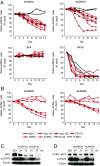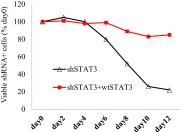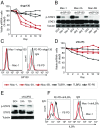Cytokine receptor signaling is required for the survival of ALK- anaplastic large cell lymphoma, even in the presence of JAK1/STAT3 mutations
- PMID: 28356514
- PMCID: PMC5393253
- DOI: 10.1073/pnas.1700682114
Cytokine receptor signaling is required for the survival of ALK- anaplastic large cell lymphoma, even in the presence of JAK1/STAT3 mutations
Abstract
Activating Janus kinase (JAK) and signal transducer and activator of transcription (STAT) mutations have been discovered in many T-cell malignancies, including anaplastic lymphoma kinase (ALK)- anaplastic large cell lymphomas (ALCLs). However, such mutations occur in a minority of patients. To investigate the clinical application of targeting JAK for ALK- ALCL, we treated ALK- cell lines of various histological origins with JAK inhibitors. Interestingly, most exogenous cytokine-independent cell lines responded to JAK inhibition regardless of JAK mutation status. JAK inhibitor sensitivity correlated with the STAT3 phosphorylation status of tumor cells. Using retroviral shRNA knockdown, we have demonstrated that these JAK inhibitor-sensitive cells are dependent on both JAK1 and STAT3 for survival. JAK1 and STAT3 gain-of-function mutations were found in some, but not all, JAK inhibitor-sensitive cells. Moreover, the mutations alone cannot explain the JAK1/STAT3 dependency, given that wild-type JAK1 or STAT3 was sufficient to promote cell survival in the cells that had either JAK1or STAT3 mutations. To investigate whether other mechanisms were involved, we knocked down upstream receptors GP130 or IL-2Rγ. Knockdown of GP130 or IL-2Rγ induced cell death in selected JAK inhibitor-sensitive cells. High expression levels of cytokines, including IL-6, were demonstrated in cell lines as well as in primary ALK- ALCL tumors. Finally, ruxolitinib, a JAK1/2 inhibitor, was effective in vivo in a xenograft ALK- ALCL model. Our data suggest that cytokine receptor signaling is required for tumor cell survival in diverse forms of ALK- ALCL, even in the presence of JAK1/STAT3 mutations. Therefore, JAK inhibitor therapy might benefit patients with ALK- ALCL who are phosphorylated STAT3<sup/>.
Keywords: ALK− ALCL; JAK; STAT; cytokine receptor; mutations.
Conflict of interest statement
The authors declare no conflict of interest.
Figures













Similar articles
-
STAT1 is phosphorylated and downregulated by the oncogenic tyrosine kinase NPM-ALK in ALK-positive anaplastic large-cell lymphoma.Blood. 2015 Jul 16;126(3):336-45. doi: 10.1182/blood-2014-10-603738. Epub 2015 Apr 28. Blood. 2015. PMID: 25921060
-
Convergent mutations and kinase fusions lead to oncogenic STAT3 activation in anaplastic large cell lymphoma.Cancer Cell. 2015 Apr 13;27(4):516-32. doi: 10.1016/j.ccell.2015.03.006. Cancer Cell. 2015. PMID: 25873174 Free PMC article.
-
ALK-Negative Anaplastic Large Cell Lymphoma (ALCL): Prognostic Implications of Molecular Subtyping and JAK-STAT Pathway.Appl Immunohistochem Mol Morphol. 2021 Oct 1;29(9):648-656. doi: 10.1097/PAI.0000000000000936. Appl Immunohistochem Mol Morphol. 2021. PMID: 33901030
-
Nucleophosmin-anaplastic lymphoma kinase: the ultimate oncogene and therapeutic target.Blood. 2017 Feb 16;129(7):823-831. doi: 10.1182/blood-2016-05-717793. Epub 2016 Nov 22. Blood. 2017. PMID: 27879258 Review.
-
JAK/STAT pathway directed therapy of T-cell leukemia/lymphoma: Inspired by functional and structural genomics.Mol Cell Endocrinol. 2017 Aug 15;451:66-70. doi: 10.1016/j.mce.2017.02.019. Epub 2017 Feb 15. Mol Cell Endocrinol. 2017. PMID: 28214593 Free PMC article. Review.
Cited by
-
Analysis and therapeutic targeting of the IL-1R pathway in anaplastic large cell lymphoma.Blood. 2023 Oct 12;142(15):1297-1311. doi: 10.1182/blood.2022019166. Blood. 2023. PMID: 37339580 Free PMC article.
-
Enhanced efficacy of JAK1 inhibitor with mTORC1/C2 targeting in smoldering/chronic adult T cell leukemia.Transl Oncol. 2021 Jan;14(1):100913. doi: 10.1016/j.tranon.2020.100913. Epub 2020 Oct 22. Transl Oncol. 2021. PMID: 33129109 Free PMC article.
-
Frequent STAT3 mutations in CD8+ T cells from patients with pure red cell aplasia.Blood Adv. 2018 Oct 23;2(20):2704-2712. doi: 10.1182/bloodadvances.2018022723. Blood Adv. 2018. PMID: 30337298 Free PMC article.
-
CD30 Regulation of IL-13-STAT6 Pathway in Breast Implant-Associated Anaplastic Large Cell Lymphoma.Aesthet Surg J. 2023 Feb 3;43(2):137-146. doi: 10.1093/asj/sjac234. Aesthet Surg J. 2023. PMID: 35999655 Free PMC article.
-
Genomic landscape of TCRαβ and TCRγδ T-large granular lymphocyte leukemia.Blood. 2022 May 19;139(20):3058-3072. doi: 10.1182/blood.2021013164. Blood. 2022. PMID: 35015834 Free PMC article.
References
-
- Kempf W. CD30+ lymphoproliferative disorders: Histopathology, differential diagnosis, new variants, and simulators. J Cutan Pathol. 2006;33(Suppl 1):58–70. - PubMed
-
- Morris SW, et al. Fusion of a kinase gene, ALK, to a nucleolar protein gene, NPM, in non-Hodgkin’s lymphoma. Science. 1994;263(5151):1281–1284. - PubMed
-
- Chiarle R, et al. The anaplastic lymphoma kinase is an effective oncoantigen for lymphoma vaccination. Nat Med. 2008;14(6):676–680. - PubMed
Publication types
MeSH terms
Substances
LinkOut - more resources
Full Text Sources
Other Literature Sources
Molecular Biology Databases
Research Materials
Miscellaneous

